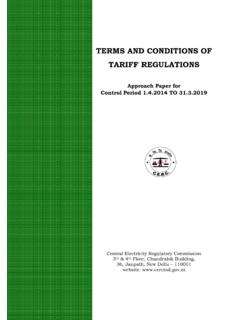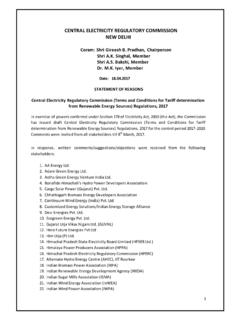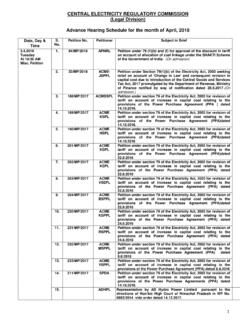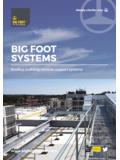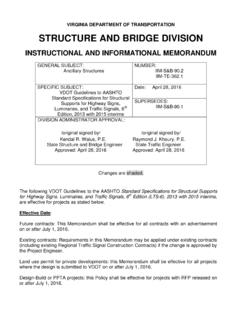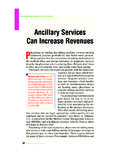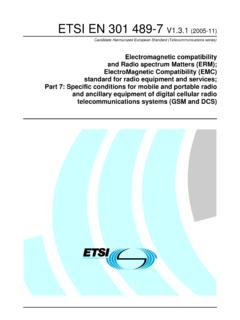Transcription of Page 1 of 17 - Central Electricity Regulatory Commission
1 Page 1 of 17 InntroduCENuction ENTRAL ELStaof AncElectriApECTRICITNEaff Pape cillary icity M pril 2013 TY REGULAEW DELHI er ServicMarket3 ATORY COI ces in IOMMISSIOPageIndianON e 2 of 17 n Introduction of ancillary Services in Indian Electricity Market I. Introduction 1. ancillary Services are support services which are required for improving and enhancing the reliability and security of the electrical power system. ancillary Services are an indispensible part of the Electricity industry. World over these services have evolved based on the prevailing structure of electric supply system and operational practices in the country. In India also, ancillary services have grown along with the grid. They have traditionally been a part of grid operation and mostly mandatory. 2. In vertically integrated utilities the responsibility of generation, transmission and distribution was with one organization.
2 ancillary services were therefore an integral part of electrical supply and not dealt with separately. However, since the liberalization of the Electricity supply industry, the resources required for reliable operation have been treated as an ancillary service that the system operator has to obtain from other industry participants. In a deregulated power system the system operator often has no direct control over individual power stations and has to purchase these services from other service providers. The design of ancillary Services market should be such that it complements system reliability. II. ancillary Services in Indian Electricity Market- Statutory Provisions 3. ancillary Services are defined, under Regulation (2)(1)(b) of the CERC (Indian Electricity Grid Code), Regulations, 2010 (IEGC) as follows : in relation to power system (or grid) operation, the services necessary to support the power system (or grid) operation in maintaining power quality, reliability and security of the grid, active power support for load following, reactive power support , black start, etc; 4.
3 One of the objectives of the IEGC, as given in Regulation is the Facilitation for functioning of power markets and ancillary services by defining a common basis of operation of the ISTS, applicable to all the Users of the ISTS . Page 4 of 17 5. The IEGC, under Regulation (g) also made operation of ancillary Services as an exclusive function of Regional Load Despatch Centres (RLDCs). 6. Regulation 8 of the Central Electricity Regulatory Commission (Power Market Regulations) Regulations, 2010, provides for the introduction of new products in Indian Electricity Market in the future, including ancillary Services Contract. The Regulation 8 is reproduced below : Notwithstanding anything contrary contained in these Regulations, no person shall enter into or transact in any of the following types of contracts unless the same has been permitted to be so launched or introduced by the Commission in terms of notification issued in this behalf - (i) Derivatives Contracts (ii) ancillary Services Contracts (iii) Capacity Contracts 7.
4 Regulation 11 (1) (b) of the Central Electricity Regulatory Commission (Unscheduled Interchange Charges and Related Matters) Regulations, 2009 provides for utilization of the amount left in the UI pool account fund towards providing ancillary services. The Regulation is reproduced below : (1) The amount left in the UI pool account fund after final settlement of claims of Unscheduled Interchange charges of the generating station and the beneficiaries shall be transferred to a separate fund as may be specified by the Commission and shall be utilised, with the prior approval of the Commission for either or both of the following activities: (a) .. (b)Providing ancillary services including but not limited to load generation balancing during low grid frequency as identified by the Regional Load Despatch Centre, in accordance with the procedure prepared by it, to ensure grid security and safety: 8.
5 In view of the above, an approach paper on ancillary Services in Indian Context was developed by NLDC in consultation with RLDCs. The paper was submitted to the Central Commission . The Commission directed the NLDC to seek comments of the stakeholders on the approach paper. Based on the comments received, NLDC filed a petition for implementation of Frequency support ancillary Services (FSAS) in the country. 9. The issue of introduction of Frequency support ancillary Service (FSAS) was discussed in the meeting of Central Advisory Committee of CERC held on 14th March 2012. In the meeting there was agreement on the following points: Page 5 of 17 (i) There was a general consensus on the need for introduction of ancillary services in India for greater security and reliability of grid operation. (ii) Introduction of ancillary service is expected to reduce dependence on UI which should be resorted to only as a last mile imbalance settlement mechanism.
6 (iii) The framework should be explained in greater detail to the stakeholders before launching it. 10. A National level workshop under the umbrella of Forum of Load Despatchers (FOLD) was organized on 15th June 2012 to explain the ancillary services mechanism to the stakeholders. The workshop was attended by representatives from CERC, Northern Regional Power Committee, Load Despatch Centres, Generating Companies and Power Exchanges. 11. Subsequent to the developments, during the hearing of the petition filed by NLDC on 10th July 2012, the Central Commission directed the staff of the Commission to come out with regulation on ancillary Services. However, it has been felt that before drafting a regulation on ancillary Services, views of stakeholders on the proposal may be invited through a staff paper. III. Staff Proposal 12. There are basically three main types of ancillary Services, viz.
7 Real power support services or Frequency support ancillary Services (FSAS)/ Load following, Voltage or reactive power support services and Black start support services. To start with, ancillary Services could be introduced for improving the reliability and security of the grid. However, given the power deficient situation in the country, it would be desirable that to start with the ancillary services be simple to implement. Frequency support ancillary Services (FSAS) 13. FSAS would be the service offered through bids by a generating station or any other authorized entity on behalf of the generating station to make itself available for despatch and get despatched/ scheduled by the nodal agency to support the system frequency. Page 6 of 17 Hence, the focus of introducing Frequency support ancillary Service (FSAS) would be to maintain the frequency within the band specified in the IEGC.
8 14. It is seen that there is some surplus generation capacity lying unutilized at some point of time but at the same time load shedding is being carried out by the utilities. Similarly, there is captive generation capacity available with industrial users like steel industries, sugar industries, etc. which are lying un-utilized and could be harnessed to supply to the inter-State grid at the time of utter need to maintain grid security. There is, therefore, a need for a mechanism such as Frequency support ancillary Services (FSAS) to utilize these un-despatched/surplus capacities to enhance the power supply to the grid, when required, to maintain grid security. 15. To start with, the generators having surplus capacity, ( either un-requisitioned surplus capacity by the beneficiaries of that capacity or generators who could not find buyers for that capacity or surplus captive capacity)may be enabled to bid into the power exchange for enhancing grid security when their services are sought by the system operator.
9 16. FSAS, at present in the Indian context, aims to stabilize the grid frequency by maximizing unutilized generation and minimizing load shedding, under certain conditions, for ensuring grid safety and security. Gradually as this market grows and imbalances are better handled with improved system security and reliability, this market could phase out the UI Mechanism. It is however pertinent to mention that introduction of ancillary services may not automatically mean a good frequency profile. 17. Integration of renewable energy in the grid is one of the biggest thrust areas. The installed generation capacity of renewable generators is expected to grow manifold in the coming years. Considering the high variability and unpredictability of generation from renewable, the FSAS would serve to stabilize the frequency for increased integration of renewable sources into the grid. Frequency support ancillary Service (FSAS) can be used to complement the diurnal changes in renewable generation.
10 FSAS can thus also be used as a mechanism to facilitate renewable integration by reducing the impact of their variation. Page 7 of 17 Eligibility Criteria 18. All the sellers and regional entities which are part of the scheduling and deviation settlement mechanism for real and reactive power with voice and data telemetry facilities in accordance with the regulations framed by the Central Commission and Central Electricity Authority to be eligible to participate in the ancillary market. No Objection Certificate (NOC)/ Standing Clearance issued by the concerned SLDC/RLDC for participation in the day ahead market in the power exchanges to be considered valid for participation in the ancillary services market subject to the condition that the capacity cleared for day ahead transaction in power exchanges for any participant plus the capacity cleared for FSAS shall not exceed the total capacity for which SLDC clearance has been obtained.


